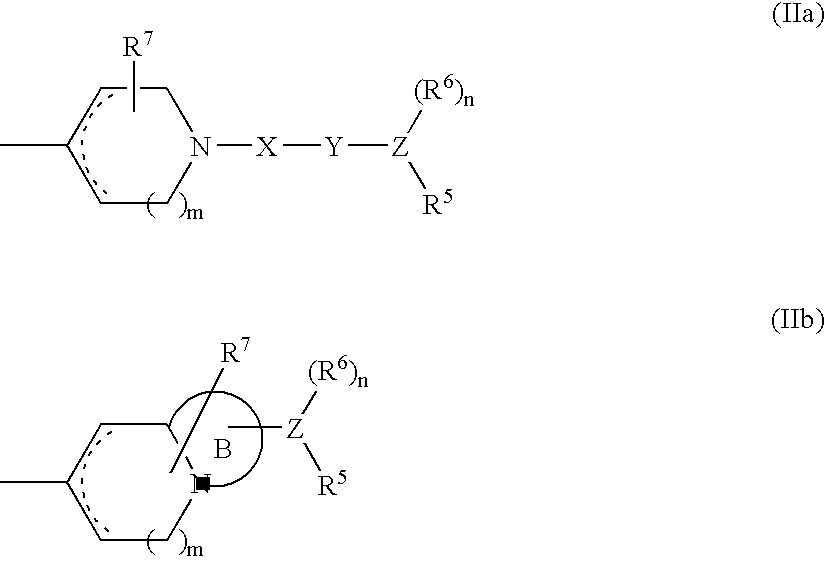Cyclic tertiary amine compound
a tertiary amine and compound technology, applied in the field of cyclic tertiary amine compounds, can solve the problems of difficult continuous long-term administration of nsaids, and achieve the effect of superior safety and marked inhibitory effect on inflammatory cytokine production
- Summary
- Abstract
- Description
- Claims
- Application Information
AI Technical Summary
Benefits of technology
Problems solved by technology
Method used
Image
Examples
example 1
4-[1-(4-Ethoxycarbonylphenethyl)-1,2,3,6-tetrahydropyridin-4-yl]-2-(4-fluorophenyl)-3-(pyridin-4-yl)-1H-pyrrole (Exemplification Compound Number 1-360)
[0438] To a solution of 2-(4-fluorophenyl)-3-(pyridin-4-yl)-4-(1,2,3,6-tetrahydropyridin-4-yl)-1H-pyrrole (compound of Example 10 described in the Specification of European Patent Publication No. 1070711) (639 mg, 2 mmol) and 4-ethoxycarbonylphenethyl bromide (1.03 g, 4 mmol) in dimethylformamide (15 ml) was added potassium carbonate (1.38 g, 10 mmol), and the resulting mixture was stirred at 80° C. for 5 hours. After stirring, water (40 ml) was added to the reaction mixture, and the resulting mixture was extracted with ethyl acetate. The separated organic layer containing the desired compound was washed with water, dried over anhydrous magnesium sulfate and evaporated in vacuo. The solid product thus obtained was washed with a small amount of methanol and re-crystallized from methanol to afford the title compound (432 mg) in a yield...
example 2
4-[1-(4-Carbamoylphenethyl)-1,2,3,6-tetrahydropyridin-4-yl]-2-(4-fluorophenyl)-3-(pyridin-4-yl)-1H-pyrrole (Exemplification Compound Number 1-366)
[0441] The title compound was synthesized in a yield of 32% as a pale brownish powder by conducting a reaction similar to that mentioned in Example 1, using 4-carbamoylphenethyl chloride instead of 4-ethoxycarbonylphenethyl bromide.
[0442] Melting point: 202-204° C.
[0443]1H-NMR (500 MHz, DMSO-d6) δppm: 11.36 (1H, s), 8.46 (2H, d, J=5 Hz), 7.88 (1H, s), 7.78 (2H, d, J=10 Hz), 7.28 (2H, d, J=10 Hz), 7.25 (1H, s), 7.16-7.10 (6H, m), 6.90 (1H, s), 5.25 (1H, s), 2.92 (2H, br.s), 2.78 (2H, t, J=10 Hz), 2.58-2.53 (4H, m), 2.16 (2H, m).
example 3
3-[1-(4-Carbamoylphenethyl)-1,2,3,6-tetrahydropyridin-4-yl]-5-(4-fluorophenyl)-4-(pyridin-4-yl)-1H-pyrazole (Exemplification Compound Number 10-366)
[0444] The title compound was synthesized in a yield of 5% as a pale yellowish powder by conducting a reaction similar to that mentioned in Example 2, using 5-(4-fluorophenyl)-4-(pyridin-4-yl)-3-(1,2,3,6-tetrahydropyridin-4-yl)-1H-pyrazole instead of 2-(4-fluorophenyl)-3-(pyridin-4-yl)-4-(1,2,3,6-tetrahydropyridin-4-yl)-1H-pyrrole.
[0445] Melting point: 182-186° C.
[0446]1H-NMR (400 MHz, DMSO-d6) δppm: 13.17 (1H, br.s), 8.50 (2H, d, J=6 Hz), 7.86 (1H, br.s), 7.75 (2H, d, J=8 Hz), 7.31-7.21 (5H, m), 7.16 (2H, d, J=6 Hz), 7.19-7.07 (2H, br.s), 5.72 (1H, br), 3.06-2.93 (2H, br.s), 2.79 (2H, t, J=8 Hz), 2.64-2.54 (4H, m), 2.37-2.12 (2H, br.s).
PUM
| Property | Measurement | Unit |
|---|---|---|
| Structure | aaaaa | aaaaa |
Abstract
Description
Claims
Application Information
 Login to View More
Login to View More - R&D
- Intellectual Property
- Life Sciences
- Materials
- Tech Scout
- Unparalleled Data Quality
- Higher Quality Content
- 60% Fewer Hallucinations
Browse by: Latest US Patents, China's latest patents, Technical Efficacy Thesaurus, Application Domain, Technology Topic, Popular Technical Reports.
© 2025 PatSnap. All rights reserved.Legal|Privacy policy|Modern Slavery Act Transparency Statement|Sitemap|About US| Contact US: help@patsnap.com



